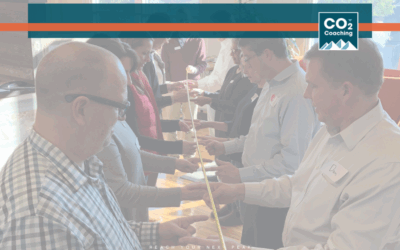The Air is Thinner at the Top – and Richer in Possibility
Let’s explore how identity evolves across a leader’s journey and why embracing a more fluid, authored sense of self is the key to reaching your next peak
As you climb closer to your next peak, something shifts. The view broadens, the air thins—and what brought you here may not get you where you’re going. For many high-performing executives, this isn’t just a metaphor; it’s a lived experience.
After years of being defined by results, roles, and recognition, stepping into something new—like coaching or a new leadership path—brings a fundamental question to the surface:
Who am I now? And who am I becoming?
This question sits at the heart of identity work and leadership transformation. It’s also where CO2 Coaching lives—at the altitude where seasoned leaders look not for maps, but for meaning.
Identity Isn’t Static—It’s a Story in Motion
At its core, identity is the internal story we tell ourselves about who we are. It’s the lens through which we interpret our experiences and make decisions. Yet, identity isn’t carved in stone. It’s shaped by our social roles, relationships, beliefs, and the feedback we get from the world around us.
Developmental psychologist Erik Erikson described identity as an evolving process, not a one-time crisis of adolescence. Each life stage—whether early career, mid-life, or legacy-building—poses new questions about who we are and who we want to become.
In CO2’s work with executives, we often meet leaders who’ve mastered their current identity but feel misaligned as they transition to something new. They’re not just facing a shift in job title; they’re renegotiating the story of themselves.
From Socialized to Self-Authored: A Shift in Mindset
Robert Kegan’s theory of adult development introduces the idea of moving from the “Socialized Mind” (defined by external expectations) to the “Self-Authoring Mind” (guided by internal values).
In practical terms, this is the leader who no longer plays a role dictated by past scripts—“the fixer,” “the achiever,” “the hero”—but instead authors a new story that reflects who they are today and what they aspire to become.
At CO2, we call this moment a summit shift. And we help leaders get there not by changing what they do, but by helping them see differently. Because when beliefs shift, behaviors follow.
Why Evolving Identity Shapes Decision-Making
Our identity is like a compass—it subtly but powerfully influences our choices. Psychologist Daniel Kahneman distinguishes between the “experiencing self” (who lives in the moment) and the “remembering self” (who crafts our life narrative).
Executives often make decisions not just based on data, but based on what fits their self-story. A choice that aligns with identity feels right. One that threatens it can create internal resistance—even if it’s logically sound.
That’s why professional transitions can feel so disorienting. They challenge not just what we do, but who we believe ourselves to be.
Coaching as Identity Work
At CO2 Coaching, we believe effective coaching isn’t just about performance—it’s about identity. When a client feels stuck, we ask not just “what’s happening?” but “who are you in this moment, and who might you become?”
We use tools like the Johari Window to uncover blind spots, the Ladder of Inference to untangle assumptions, and mindfulness to help clients pause and reflect rather than react. These practices expand awareness, build self-compassion, and make room for new identities to emerge.
A leader might begin by saying, “I’ve always been the one with the answers.” Through coaching, they might come to say, “Now I see myself as someone who asks better questions.” That’s not a performance shift—it’s a paradigm shift.
Professional Identity as Both Mirror and Cage
Careers often become containers for identity. The lawyer becomes “the closer.” The CFO becomes “the one who never flinches.” These roles bring meaning—but can also become golden cages.
Herminia Ibarra notes that identity shifts during career changes often spark resistance from both self and others. People around us have “identity deals” with us. When we change, we’re not just disrupting our own story—we’re challenging theirs.
Coaching supports this renegotiation. It helps leaders step into new possibilities—like becoming a guide instead of a warrior—without abandoning the values that got them here.
The Anatomy of an Identity Transition
Let’s break it down:
- The Before: Defined by mastery, clarity, certainty. You’re known and know yourself.
- The Middle: Ambiguity, doubt, discovery. The old identity loosens; the new one isn’t fully formed.
- The After: Integration. You don’t discard the past—you remix it to align with who you are now.
This liminal space—the “messy middle”—is where CO2 Coaching thrives. We don’t hand you a map. We hike beside you, asking the right questions, guiding with wisdom, curiosity, and heart.
Tools for Evolving Identity
Here’s a toolkit to support identity work in leadership:
- Johari Window: Gain insight into how others see you—and how you see yourself.
- Ladder of Inference: Slow your thinking. Spot where assumptions drive identity-based reactions.
- Mindfulness: Observe your identity from a distance. Choose responses aligned with values, not ego.
- Somatic Awareness: Tune into the body. It often knows before the mind when something doesn’t fit.
These tools don’t just manage behavior—they evolve identity. They’re the ice axe and ropes for your next ascent.
Reach Your Next Peak (and Elevate Others as You Climb)
Here’s the truth: Leadership isn’t a static summit. It’s a series of climbs. And each new peak demands not just more skill—but a new sense of self.
At CO2 Coaching, we elevate leaders so they can elevate others. Your transformation doesn’t stop with you—it cascades through your team, your organization, and your world.
So ask yourself not just “What do I want to do next?” but “Who do I want to be next?”
Then start writing that next chapter. We’ll help you hold the pen.



